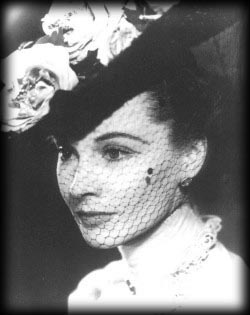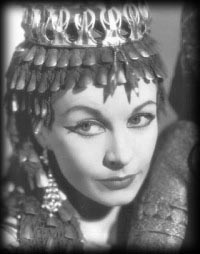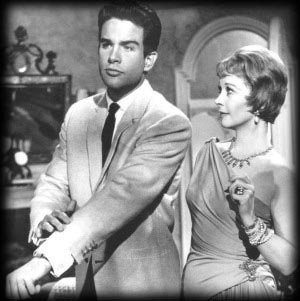The script of The Roman Spring of Mrs. Stone
When first approached, Vivien did not want to play the part. She had read the novel, and- alarmed, I think, by Tennessee's physical description of the character- found the portrait of an aging actress exploited by an Italian gigolo too "cruel" and too "grotesque" (her words). Then she read the script and changed her mind. Our first discussion took place at the London flat she and Olivier had bought a few years before. She was indeed beautiful, also calm and smiling. The only sign of edginess was the number of cigarette packs scattered around the room- a new brand called Olivier. With a hint of apology, she asked me to rewrite the opening scene. In order to establish that Karen Stone had begun to play roles in the theater for which she was too old, I had shown her as Viola in Twelfth Night, standing in the wings disguised as her twin brother Sebastian. The actor playing Sebastian, in an identical costume, came up to her, and as the camera moved closer it revealed how much older she looked than Sebastian. It wasn't the aging that Vivien objected to, only the way the point was made. She confessed, with a sudden scream of laughter, that after the movie she planned to play Viola in Twelfth Night, and why give the critics free ammunition? She was right, of course, and she was right about a few lines she asked me to cut. "I don't have to say them," she explained. "I can play them." Two weeks before shooting started, Vivien announced that she felt herself going "dry," and that she would take a shock treatment the next day. She mentioned this to Quintero and me with no more fuss than someone with a headache asking for an aspirin. Her lack of self-pity was touching and elegant. The next afternoon at rehearsals she appeared eager and energetic. With her divorce case coming up and with reporters waiting at her door, she was under great strain. She'd go off for occasional further treatments, but there was no crack in her composure, personal or professional. Like her character, Mrs. Stone, she disciplined her terror. As so often happened in her career, life and art overlapped. Twenty years earlier, after winning an Oscar for Gone With the Wind (1939), Vivien Leigh had been the most famous movie actress in the world. She was only twenty-six then, and would go on to make only nine more movies. Few stars have had such an impact with so few appearances, but Vivien was never a conventional star. Under Olivier's influence, she devoted most of her time to theater. While she achieved her greatest success in Hollywood, she continued to live in England. Her brilliant career was repeatedly halted by physical and mental illnesses.
Of her early, mainly unremarkable British movies, only The Sidewalks of London (1940)- in Britain it was titled St. Martin's Lane (1938)- gave a hint of the actress who would grasp Scarlett so completely. She played a thief who joined a band of street entertainers and eventually became a musical comedy star. It was a warm-up for two of her greatest roles, Scarlett and Cleopatra. She was at once both light and ruthless, ambitious and romantic. In Sidewalks you could also sense her affinity for the camera. She had essential, magical screen presence, definite and slightly mysterious. (It was never the same, by the way, in the theater. She lacked Olivier's classical range, and although she gave some remarkable performances, in The Skin of our Teeth, Anouilh's Antigone, and Chekhov's Ivanov, it seemed more of an effort for her to command the stage.) She glowed then when she was in front of a camera, she was vital and confident. She knew how to grade her effects and, from long shot to close-up, how to communicate without words. The pattern of her later screen career was set by her role in Streetcar. Drifting, vulnerable, it looked all the way forward to her last movie, Ship of Fools, in which she played another Southern lady on the skids. (Curious how the American South haunted an actress born of British parents in India, brought up in convent schools in England and Europe, and presented at court as a debutante.) Kazan's technique in Streetcar looks fairly dated now, and its effects overblown. Vivien and Brando play in different styles, yet her performance remains uncannily immediate in its deceitful frayed elegance, in its premonitions of defeat, and in its pathetic struggle for survival. In Streetcar, she is Scarlett gone wrong. Almost 15 years later, as Mary Treadwell in Ship of Fools, she is Blanche continuing her struggle. As in Vivien's life, the odds against her are greater each time, and the effect increasingly poignant. Once, when a reporter asked her how she extended her range as an actress, she answered wryly: "Life." It was true, but not the whole truth, for some of her finest qualities as an actress were the intelligence, will, and humor that enabled her to keep, her own neuroses from the screen. In all her work there is nothing more precise and revealing than the moment in Ship of Fools when, alone in the ship's corridor, she breaks into a wild Charleston. It is disturbing yet funny, a comment on herself as a romantic, a woman who knows time is running out and refuses to complain. It seems like an echo of the moment in Gone With the Wind when Scarlett, a widow trying to merry at the Atlanta ball, jiggles to the music all by herself. The studio contract system was at its most powerful when Vivien became a star, but she fought it from the first. Her contract with Selznick committed her to make one picture a year for seven years, but in fact they never worked together again after GWTW. He loaned her to MGM for the bland Waterloo Bridge (1940); refused to let her play Katherine in Olivier's film of Henry V (1944); and tried unsuccessfully to exercise his power of veto again for the stage production of The Skin of Our Teeth.
With directness and grace, she communicated on the screen her early promise, then later her sense of loss. Her subtlety lay in the manner in which she related to both, hinting marvelously at the loss that would overtake Scarlett's promise, and the promise that lay behind Blanche's loss. You can "read" Vivien Leigh's screen performances chronologically as if she were a character in a time-spanning novel. GAVIN LAMBERT wrote the screenplays for The Roman Spring of Mrs. Stone, Inside Daisy Clover, Vivien Leigh, and two films for which he received Academy Award nominations: Sons and Lovers and I Never Promised You a Rose Garden. He is the author of several books, including The Slide Area, The Goodbye People, On Cukor, and The Dangerous Edge, and was, in the early fifties, the editor of the film magazine Sight and Sound. taken from Close-Ups: Intimate Portraits of Movie Stars by their Co-Stars, Directors, Screenwriters and Friends; Edited by Danny Peary; Galahad Books: New York City. Copyright 1978. |
 (1961) was not
written with Vivien Leigh in mind. While I was working on it, various people suggested
actresses for the part, but none of them seemed right to Tennessee Williams, to the
director Jose Quintero, or to myself. Then, one day Tennessee said, "Vivien must play
it." We immediately realized she was ideal. Why hadn't anyone thought of her
before? At the time, 1960, she had not made a movie for five years (The Deep Blue Sea,
1955); the year before, she had collapsed during the first weeks of Elephant Walk
(1954) and had been replaced by Elizabeth Taylor. She was separated from Laurence Olivier,
a divorce was imminent, and those who claimed inside knowledge of her
"condition" predicted another breakdown. She was a risk- a wonderful actress
certainly, still beautiful, but a risk.
(1961) was not
written with Vivien Leigh in mind. While I was working on it, various people suggested
actresses for the part, but none of them seemed right to Tennessee Williams, to the
director Jose Quintero, or to myself. Then, one day Tennessee said, "Vivien must play
it." We immediately realized she was ideal. Why hadn't anyone thought of her
before? At the time, 1960, she had not made a movie for five years (The Deep Blue Sea,
1955); the year before, she had collapsed during the first weeks of Elephant Walk
(1954) and had been replaced by Elizabeth Taylor. She was separated from Laurence Olivier,
a divorce was imminent, and those who claimed inside knowledge of her
"condition" predicted another breakdown. She was a risk- a wonderful actress
certainly, still beautiful, but a risk. She had her
first breakdown after Caesar and Cleopatra (1946), and a year later medical tests
revealed a tubercular patch on her lung. Not coincidentally, the Shaw movie was the last
in which she played a character with direct Scarlett O'Hara affinities. She followed it
with Anna Karenina (1948), a misfire that pointed to the tragic element
underlying all her later work, from A Streetcar Named Desire (1951) to Ship
of Fools (1965).
She had her
first breakdown after Caesar and Cleopatra (1946), and a year later medical tests
revealed a tubercular patch on her lung. Not coincidentally, the Shaw movie was the last
in which she played a character with direct Scarlett O'Hara affinities. She followed it
with Anna Karenina (1948), a misfire that pointed to the tragic element
underlying all her later work, from A Streetcar Named Desire (1951) to Ship
of Fools (1965). But even if her first commitment had been to movies, instead of
to Olivier and the theater, one wonders how different the result would have been. Her
great early success as Scarlett presented problems; a triumph of this magnitude becomes a
kind of albatross. Perhaps she avoided it by making so few movies and leaving us to ask
for more. Likewise, she fought to avoid the trap of her beauty. After Anna Karenina,
which she made when she was thirty-two, she moved into "character" roles,
deliberately ravaging herself for Streetcar, and in her mid-forties, rather than
trying to look younger, confronted middle age in Mrs. Stone and Ship of Fools.
But even if her first commitment had been to movies, instead of
to Olivier and the theater, one wonders how different the result would have been. Her
great early success as Scarlett presented problems; a triumph of this magnitude becomes a
kind of albatross. Perhaps she avoided it by making so few movies and leaving us to ask
for more. Likewise, she fought to avoid the trap of her beauty. After Anna Karenina,
which she made when she was thirty-two, she moved into "character" roles,
deliberately ravaging herself for Streetcar, and in her mid-forties, rather than
trying to look younger, confronted middle age in Mrs. Stone and Ship of Fools.